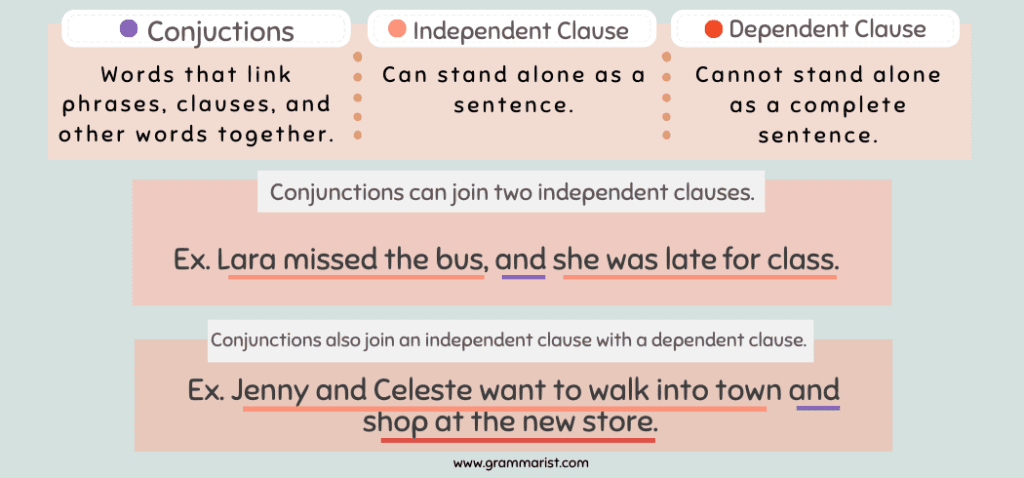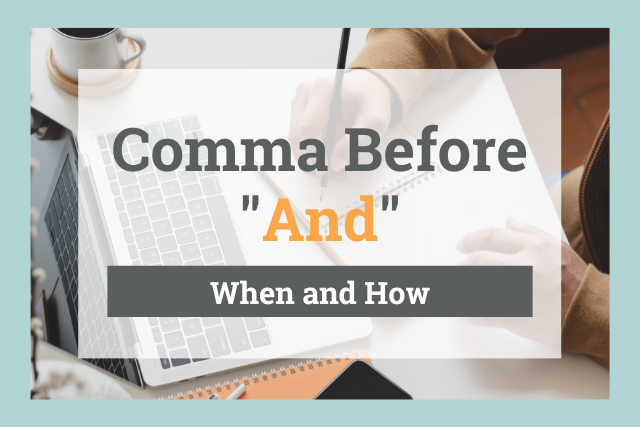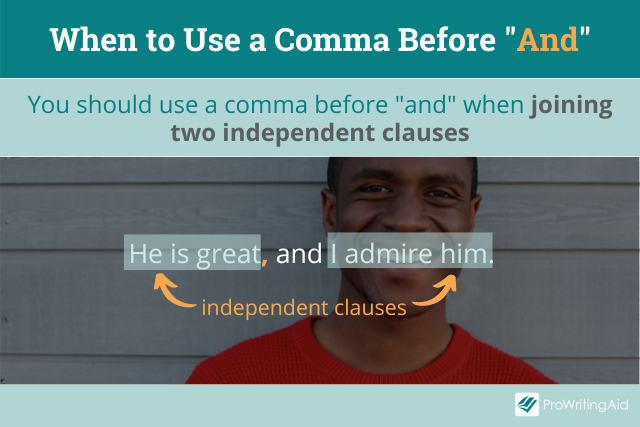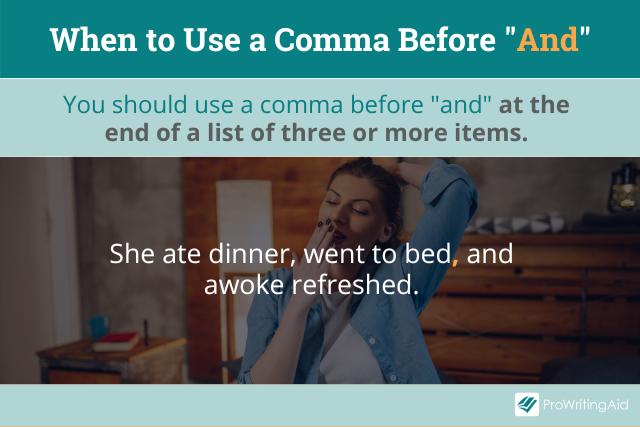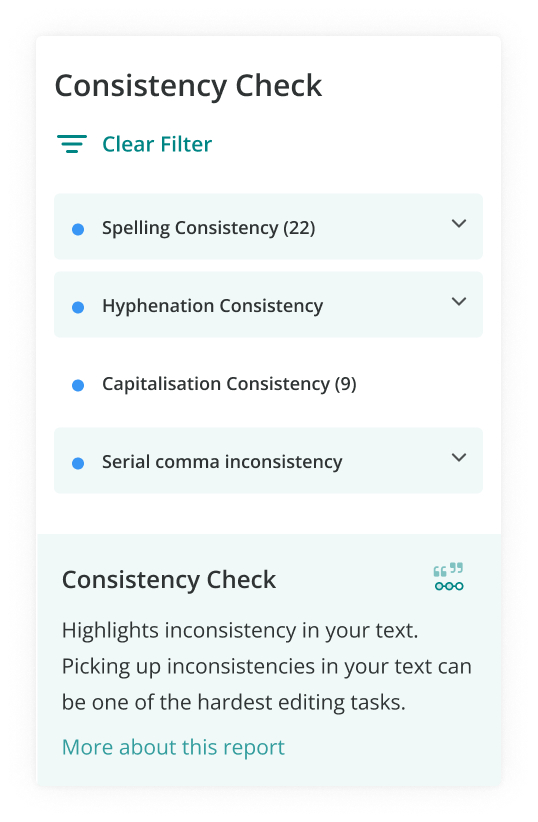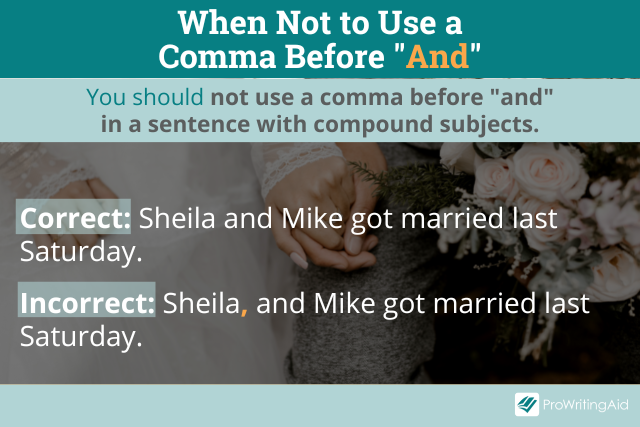Commas are probably one of the most confusing punctuation marks to use, and even I struggle to find ways to help my students determine where they belong.
One of the most commonly asked questions I hear surrounds whether to place a comma before or after the word “and.” Unfortunately, the answer is not quick or simple. However, the comma rules concerning the word “and” is not difficult to understand.
I’m going to start simple and explain how the word “and” is used and then provide rules on punctuation surrounding comma usage so you can understand where they belong together. I’ve also provided plenty of examples below.
Common Coordinating Conjunctions and Compound Sentences
Conjunctions are words that link phrases, clauses, and other words together. They allow you to form compound-complex sentences to enhance the flow of your writing and speech.
Coordinating conjunctions include the words for, and, nor, but, or, yet, and so. The guide to comma usage in relation to conjunction use are the same for all of them, but the word “and” is more used than any other choice.
Conjunctions can join two independent clauses or clauses that could work as stand-alone sentences.
For example, the following two independent clauses:
- Lara missed the bus. She was late for class.
Becomes
- Lara missed the bus, and she was late for class.
Conjunctions also join an independent clause with a dependent clause or clause that cannot stand alone as a complete sentence.
For example:
- Lara needs to start getting to class on time and make sure her homework is complete.
Rules of Comma Usage
There are six basic rules of comma use, but I find it is much easier to teach each rule independently of one another with plenty of examples. Such is the case with commas and conjunctions.
Using “And” to Join Two Independent Clauses: Comma BEFORE “And”
When “and” joins together two independent clauses, a comma needs to be placed before the “and.” Independent clauses are complete sentences, but their conjoining makes a complex-compound sentence. The comma works to indicate this use.
For example:
- I hate having to get up early for work, and getting chores done at that time of the morning is exhausting.
- It hasn’t rained in our town or the surrounding areas, and the lack of rain is starting to make everyone very anxious.
- I’m so glad the end of the week is nearing, and I can’t wait until I can sleep in this weekend.
Using “And” with a Dependent Clause: No Comma
If you are joining together an independent clause with a dependent clause, you do not use a comma.
For example:
- Jenny and Celeste want to walk into town and shop at the new store.
- Wyatt wanted to study Marine Biology and go to a summer camp for more experience.
- Sarah got in big trouble at school for fighting and was suspended for ten days.
Using “And” with Short Independent Clauses: No Comma
Even though they are technically independent, it is acceptable to avoid the comma for shorter sentences.
For example:
- Emmett likes trains and Emily likes horses.
- Mary likes math and John likes writing.
- Javier likes football and Mark likes lacrosse.
Using “And” with List Items:
Depending on how many items you have to list determines whether you use commas in lists with the “and.” There are also multiple ways to approach whether you use a comma or not, which can cause quite a bit of confusion.
Take a look at the examples below to determine which approach works best for you.
Two Items: No Comma
When listing two items, you do not use a comma before the “and.”
For example:
- I need to run to the store for milk and butter.
- She couldn’t decide between art and choir.
- He played in the band and played football.
Three or More Items: Serial Comma BEFORE “And”
The use of a comma before the word “and” when listing three or more items has been a topic of hot debate for many years. This quirk of comma usage is called a serial comma – a comma used in a series of items. It is also called the Oxford comma.
The Oxford comma’s rules state that a comma belongs between the last two items in a series of three or more items to avoid ambiguity. The serial comma controversy is addressed in the the AP Style Guide stating the Oxford comma is grammatically incorrect. But, linguists everywhere will agree it is a grammatical option.
In fact, there has been a lawsuit about a job description that offered two different interpretations of an exception rule: in this case, whether overtime was owed. The judge ruled an Oxford comma was required to include the last item in the list concerning exception, but since it was not used, the item was not part of the list, and overtime was indeed owed.
I also teach the Oxford comma in order to ensure clarity and avoid confusion. Without it, some pretty amusing situations can occur.
For example:
- Rachel finds inspiration in cooking, her dog and family.
- We went to the concert with neighborhood friends, Grandma and Grandpa.
The first sentence sounds like Rachel cooks her dog and her family. In the second sentence, it sounds like the neighborhood friends are named grandma and grandpa.
Instead of accidentally creating this confusion, simply use an Oxford comma to create clarity.
For example:
- Rachel finds inspiration in cooking, her dog, and her family.
- We went to the concert with neighborhood friends, Grandma, and Grandpa.
When to Use Commas AFTER “And”
A comma is almost never used after the word “and.” However, there are a few exceptions. In general, do not place a comma after “and” unless the following is true:
“And” is Used to Introduce a Parenthetical Expression
A parenthetical expression is a non-essential phrase that is offset from the main sentence to add detail or information.
For example:
- I have to drive to Texas every two weeks for a doctor’s appointment, and, if I’m lucky, I have extra time to do a little shopping.
“And” is Used in a Line of Dialog
Written dialog may require a comma following an “and” depending on the style and tone the author is trying to create with a character.
For example:
- “And,” Michael dictated, “you have to be up two hours before daybreak if you want to get there on time.”
Let’s Review
A comma is almost never used after the word “and,” barring a few exceptions, but it is commonly used before when you combine two complete sentences into a compound sentence or when listing more than two items.
It is important to use commas properly to avoid overuse and help ensure writing clarity. Like I tell my students, when you look at one grammar rule at a time and practice its application, you will almost always remember its use.
Like many English comma rules, whether or not you use a comma before «and» depends on the situation. There are two instances when you should use a comma before «and.»
First, use a comma when «and» joins two independent clauses. You can also use a comma when «and» precedes the last item in a list. This is called an Oxford comma.
Today, we’re taking a closer look at the rules about using a comma before «and» in sentences.
If your comma skills are rusty, you can always use ProWritingAid’s free grammar checker to find all your misplaced and missing commas.
Do You Put a Comma Before «And»?
There are two main instances when you should put a comma before «and» in a sentence. Let’s dive into each rule in more detail.
Comma Before «And» When Joining Independent Clauses
To understand how to use a comma before «and,» you need to understand the difference between independent clauses and dependent clauses.
An independent clause is a statement that can stand alone as a complete sentence. Independent clauses always have a subject, a verb, and express a complete thought.
A dependent clause is a statement that cannot stand alone as a complete sentence. It may have a subject and a verb, but it is an incomplete thought.
Coordinating conjunctions can link two independent clauses. The seven coordinating conjunctions are: for, and, nor, but, or, yet, so.
When «and» combines two independent clauses, you should use a comma before “and.” This rule applies to any coordinating conjunction that joins two independent clauses.
Correct: He is great, and I admire him.
Incorrect: He is great and I admire him.
Both clauses can stand alone as a complete sentence. We could say, «He is great. I admire him.» We used «and» to join the independent clauses, so we put a comma before «and.»
It’s important to note that you should only use a comma to join independent clauses if a coordinating conjunction like «and» is present.
If you combine two independent clauses with just a comma and no conjunction (e.g. He is great, I admire him.), this is called a comma splice. It’s grammatically incorrect.
Comma Before «And» in a List
The other situation where you should place a comma before «and» in a sentence is in a list. The Oxford comma, also called a serial comma, precedes «and» before the last item in a list.
To use an Oxford comma, there should be three or more items in a list. If there are only two items, you do not need a serial comma before «and.»
Correct: She ate dinner, slept all night, and awoke refreshed.
Incorrect: She ate dinner, and awoke refreshed.
The Oxford comma is grammatically correct, but it is not required. It used to be more common not to use it, but it’s become the preferred comma usage.
If you prefer to write a list without the Oxford comma, that’s fine. However, you should check any style guides if you’re doing business or technical writing.
The important thing is to be consistent with your serial comma usage. Don’t use the Oxford comma part of the time and leave it out the rest.
ProWritingAid’s Consistency Report will help make sure you are sticking with one rule or the other.
Comma Before «And More»
You can also use an Oxford comma before «and more» if your list ends with this phrase. In these situations, «more» acts as the last item in a list.
Let’s look at an example of how this might look.
- The rehearsal dinner included tacos, enchiladas, elote, frijoles charros, and more.
However, the comma before «and» is optional because it is a serial comma.
Do You Put a Comma After «And»?
If you use a comma with «and,» it should always precede the word «and.» You should never put a comma after the word «and.»
This rule applies to both independent clauses joined by «and» and lists of three or more items, as well as any other time «and» might appear in a sentence.
It also applies to all other coordinating conjunctions; you should never put a comma after a coordinating conjunction.
Correct: We met for lunch, and we spent two hours chatting at the restaurant.
Incorrect: We met for lunch and, we spent two hours chatting at the restaurant.
Correct: My pets include two rats, three hamsters, and a ferret.
Incorrect: My pets include two rats, three hamsters and, a ferret.
Remember, commas can precede «and» but can’t follow it.
When Shouldn’t You Use a Comma Before «And»?
You should only use a comma before «and» in a list or when joining two independent clauses.
«And» sometimes joins an independent clause with a phrase that isn’t a complete thought. This incomplete thought usually takes the form of either a compound subject or a compound predicate.
When this happens, do not use a comma before «and.»
Here’s an example of «and» in a compound subject:
Correct: Sheila and Mike got married last Saturday.
Incorrect: Sheila, and Mike got married last Saturday.
Sheila and Mike are both subjects, so this is a compound subject. No comma is required.
Now, let’s look at an example of a compound predicate that uses «and.»
Correct: The baby drank a bottle and went to sleep.
Incorrect: The baby drank a bottle, and went to sleep.
In this example, «went to sleep» is not a complete thought. There’s no subject, so it’s not an independent clause and therefore does not require a comma.
Examples of Comma Before «And» in Sentences
Here are a few more examples of how to use a comma before «and» in a sentence.
- A librarian can recommend a good book, and they can also help you with research.
- Lavender plants smell great, and they also repel mosquitos.
- After work, I went to the grocery store, the post office, and the gas station.
- Christy got gift cards, a bottle of wine, bath bombs, and new shoes for her birthday.
Comma rules can be tricky because there are so many scenarios where we need this versatile punctuation mark.
Just remember that you should only put a comma before «and» when joining two independent clauses or in a list of three or more things.
Take your writing to the next level:
20 Editing Tips From Professional Writers
Whether you are writing a novel, essay, article, or email, good writing is an essential part of communicating your ideas.
This guide contains the 20 most important writing tips and techniques from a wide range of professional writers.

Table of Contents
- What is it called when extra information is added to a sentence?
- What is a phrase separated by commas called?
- Can you use 2 commas in a sentence?
- How many commas is too many in a sentence?
- How many commas are in a million?
- Is in turn separated by commas?
- Does after all need a comma?
- Does obviously need a comma?
- How do I use which in turn?
- Do you put a comma after however?
- Should however have two commas?
- How do you use However in two sentences?
- Can you use however and therefore in the same sentence?
- Should there always be a comma after therefore?
- What kind of word is therefore?
- Can you put therefore in the middle of a sentence?
- What punctuation do you use with therefore?
- Is therefore a transition word?
- How do you use thus in the middle of a sentence?
- What kind of word is than?
- What is the difference between so and hence?
- How do you use hence correctly?
- What is difference between Hence and therefore?
The word and is a conjunction, and when a conjunction joins two independent clauses, you should use a comma with it. The proper place for the comma is before the conjunction. Therefore, we need a comma before and. Don’t use a comma before and when one of the clauses it’s connecting is a dependent clause.
A parenthetical expression is a word or words added to a sentence without changing the meaning or grammar of the original sentence. Parenthetical expressions give extra information but are not essential. You can add and remove a parenthetical and the sentence works just the same.
What is a phrase separated by commas called?
Nonessential words, clauses, and phrases that occur midsentence must be enclosed by commas. The closing comma is called an appositive comma. Many writers forget to add this important comma. Following are two instances of the need for an appositive comma with one or more nouns.
Can you use 2 commas in a sentence?
You can use two commas for three items, or if you’re like me you obsess over the Oxford Comma.
How many commas is too many in a sentence?
If you feel you have too many commas, you do. Like, no one can say you should have twenty-seven commas per page or anything like that. The first question would be, Do you have commas in inappropriate places? If you have sentences like, “Bob walked, to, the store, slowly” then yes, there are too many commas.
How many commas are in a million?
How Many Zeros in a Million? How Many Zeros in a Billion? Reference Chart
| Name | Number of Zeros | Written Out |
|---|---|---|
| Ten Thousand | 4 | 10,000 |
| One Hundred Thousand | 5 | 100,000 |
| One Million | 6 | 1,000,000 |
| Billion | 9 | 1,/b> |
Is in turn separated by commas?
the use of which in turn requires the use of commas. There are a few problems with the sentence you propose, but your use of “in turn” is correct. Second, the first word in the sentence, “affective,” may be incorrect. This word is rarely used outside of technical pulications in a few fields.
Does after all need a comma?
A comma seems usual if you start a sentence with After all. No commas are generally used if you end a sentence with after all. Otherwise there is nothing to indicate that you must have put a comma before and after the phrase.
Does obviously need a comma?
“Obviously” should be succeeded with a comma when it is used as an introductory expression in a sentence, also known as a disjunct. Also, a post-comma should be placed when “obviously” is used as the last word in a parenthetical expression inserted mid-sentence.
How do I use which in turn?
“Which in turn” means “because of that” or “one after the other.” You can use the phrase “which in turn” as a synonym for these phrases. We often use the word “which” as a replacement for “that,” but you should use “which” only for specific clauses. The key is to know when to add the word “which” and when to skip it.
Do you put a comma after however?
Use a semi-colon (;) before and a comma (,) after however when you are using it to write a compound sentence. If ‘however’ is used to begin a sentence, it must be followed by a comma, and what appears after the comma must be a complete sentence. However, there was no need to repeat the data entry.
Should however have two commas?
In a nutshell, however is an adverb, not a true conjunction, so it can’t join two independent clauses with just a comma. But either way, however should be set off by commas. When it’s in the middle of a clause, the commas go on both sides; when it’s at the beginning of a clause, it just needs a following comma.
How do you use However in two sentences?
1. As a conjunctive adverb, however is used to combine two sentences and show their contrast or opposition. In this case, use a semicolon (;) before and a comma (,) after the word however. o The festival was to be held today; however, it was canceled due to the rainy weather.
Can you use however and therefore in the same sentence?
You cannot use commas around however here. You need two separate sentences or a semicolon (or conjunction). You cannot use commas around therefore here. You need two separate sentences, a semicolon, or the addition of a conjunction.
Should there always be a comma after therefore?
Conjunctive adverbs as introductions In this sentence, the first comma is used to separate the first independent clause from the second independent clause, and the second comma is needed after the introductory word therefore. You do not need a third comma between and and therefore.
What kind of word is therefore?
conjunctive adverb
Can you put therefore in the middle of a sentence?
Using therefore is perfectly acceptable as long as you partner it with the right punctuation, although it can get a bit confusing as it does have different uses. You can put it in the middle of a sentence with two commas, and it can also be placed at the start of a sentence.
What punctuation do you use with therefore?
comma
Is therefore a transition word?
Some of these transition words (thus, then, accordingly, consequently, therefore, henceforth) are time words that are used to show that after a particular time there was a consequence or an effect.
How do you use thus in the middle of a sentence?
If “thus” is used as a conjunctive adverb (without “and”), a semi-colon and a comma are necessary. This version of your sentence is also correct: “Accepted theories can provide satisfactory results; thus, experiments can be avoided.”
What kind of word is than?
Than is a grammatical particle analyzed as both a conjunction and a preposition in the English language. It introduces a comparison and is associated with comparatives and with words such as more, less, and fewer. Typically, it measures the force of an adjective or similar description between two predicates.
What is the difference between so and hence?
As adverbs the difference between so and hence is that so is to the (explicitly stated) extent that while hence is (archaic) from here, from this place, away.
How do you use hence correctly?
The school closed down last month; hence, the students all had to find a new school. In this case, ‘hence’ comes right after the semicolon and is followed by a comma. It can also be used at the beginning of a sentence to show relationship to the previous sentence, like this: Jerry retired from the firm last year.
What is difference between Hence and therefore?
When used as adverbs, hence means from here, from this place, away, whereas therefore means for that or this purpose, referring to something previously stated.
If you see a comma after a conjunction, it is pretty close to always wrong. There is a normal use, but not usually.
«and» can be used as a coordinating conjunction or as a list or to join two nouns. (This applies to all conjunctions, not just and.)
Coordinating Conjunction:
- He went to the store and bought milk. (Without the pronoun a second time)
- He went to the store, and he bought milk. (With the pronoun a second time)
List:
- He has a pencil, a notebook, and a math book. (Chicago style)
- He has a pencil, a notebook and a math book. (AP Style)
Join two nouns:
- Jack and Jill stopped by.
- The sides were peas and brussel sprouts.
Ok, now in none of these sentences is there a comma after the word «and«.
Now, what if you add an interrupter or parenthetical element immediately after the word «and«?
Unfortunately, andyvn22 led you astray ever so slightly by saying the comma is allowed to offset the interrupter or parenthetical element. He forgot the rule that the interrupter or parenthetical element doesn’t need a comma at the start if it begins a sentences or follows a conjunction.
Coordinating Conjunction:
- He went to the store, and with little thought, bought milk. (Without the pronoun)
- He went to the store, and with little thought, he bought milk. (With the pronoun)
Because these are coordinating conjunctions, the and is already a separator and no additional separator, such as a comma, is needed for the parenthetical element.
In the first sentence, even though a comma is not required because the second sentence cannot stand on its own, the comma is used before the coordinating conjunction because a parenthetical element follows it and strengthens the need for the comma.
List:
- He has a pencil, a notebook, and just sticking out of his backpack, a math book. (Chicago style)
- He has a pencil, a notebook, and just sticking out of his backpack, a math book. (AP Style)
Now, AP style will have the comma in this situation, and so both AP and Chicago are the same.
As you see, because «and» is already a separator, you don’t need a comma for an interrupter or parenthetical element. However, an interrupter or parenthetical element strengthens the need for a comma before the conjunction. I know this contradicts what andyvn22 says. So a comma is allowed, but it is allowed before the conjunction, not after.
What about this: «A sentence must still be grammatically correct when removing the interrupter or parenthetical element?»
While that statement is correct, that doesn’t mean the comma should be after the conjunction. The logical flaw that might lead one to believe this is assuming that when removing the interrupter or parenthetical element that you also remove the conjunction. You don’t. The conjunction is not removed with the interrupter or parenthetical element just because a comma precedes the conjunction. Now, removing the interrupter or parenthetical element may weaken the need for a comma and you may end up removing the comma, too, but that doesn’t mean the comma or the conjunction were part of the interrupter or parenthetical element.
Join two nouns:
- Jack and, to my joy, Jill stopped by.
- The sides were peas and, to my distaste, brussel sprouts.
Here the conjunction is not coordinating, and not already separated by a serial comma.
So, when should and be followed by a comma?
Answer:
- When the
andis not a coordinating conjunction or not in a serial making the serial comma available. - When you are talking about the words themselves and not using the word. For example, if you want to list all the conjuctions:
and, but, or, yet, for, nor, so.That is the only time a comma should follow a conjunction.
Don’t think that just because you see a comma after a conjunction in your favorite author’s novel that it is correct. This is a very obscure rule and many, many writers get it wrong.
Published on
July 14, 2022
by
Jack Caulfield.
Revised on
March 20, 2023.
In English, you must put a comma before “and” when it connects two independent clauses. A clause is independent when it could stand on its own as a sentence—it has its own subject and verb.
But when “and” connects two verbs with the same subject, you shouldn’t use a comma.
In this case, Jagmeet is the subject who performs both actions (walking and arriving).
Table of contents
- Comma before “and” connecting independent clauses
- When you don’t need a comma before “and”
- When do you need a comma after “and”?
- Worksheet: Comma before or after and
Comma before “and” connecting independent clauses
You can recognize that you need a comma before “and” when you’re connecting two clauses with separate subjects and verbs.
This applies even when the second subject is a pronoun referring to the same person or thing as the first subject, or when the second clause repeats the same verb from the first.
Bob went to church on Sunday morning, and he handed out flyers in the afternoon.
It rained yesterday, and it didn’t rain today.
But it’s often better to simplify phrasings like these by omitting the second subject. This way, you remove the need for a comma and make the sentence less repetitive.
Bob went to church on Sunday morning and handed out flyers in the afternoon.
It rained yesterday and not today.
Most style guides do make an exception for short sentences where the two independent clauses are simple and closely related. In these cases, the comma is optional.
Janice speaks, and Justine listens.
When you don’t need a comma before “and”
As a conjunction, “and” can also connect all kinds of different words: adjectives, verbs, nouns, and so on. When “and” joins two words like this, rather than joining two full independent clauses, it’s incorrect to use a comma.
- Jeremy, and Paul have three cats.
- Jeremy and Paul have three cats.
- The wallpaper was blue, and green.
- The wallpaper was blue and green.
- To support my friend, I listened to him, and gave advice.
- To support my friend, I listened to him and gave advice.
However, at the end of a list of three or more items, a comma may be used before “and.” This is called the Oxford comma (or serial comma). It’s usually recommended to use it.
When do you need a comma after “and”?
As a general rule, you don’t need a comma after and. Even if you start a sentence with an introductory “and,” you should not place a comma after it.
- The future is bright. And, it’s coming faster than you think.
The only occasion when a comma might appear after “and” is when the sentence is interrupted at that point by a parenthetical phrase set off by commas.
The headphones are broken and, for all intents and purposes, useless.
Worksheet: Comma before or after and
Do you want to test your knowledge about when to use a comma before or after and? Use our practice worksheet below. Just insert commas into the sentences wherever you think they’re needed, and then check your work against the answers provided.
- He traveled to France on Thursday and she followed on Friday.
- Julia and I are going to a concert and Siobhan might join us.
- My favorite vegetables are broccoli cucumber and zucchini.
- The old man sighed and walked away.
- My partner cooks and I clean.
- I’m surprised and to be honest disappointed.
- He traveled to France on Thursday, and she followed on Friday.
- The “and” here connects two independent clauses, so a comma is needed.
- Julia and I are going to a concert, and Siobhan might join us.
- The first “and” just connects the two subjects, so there’s no comma. The second “and” introduces a second independent clause, so a comma is used.
- My favorite vegetables are broccoli, cucumber(,) and zucchini.
- The first comma is necessary to separate the first two items in the list. The one before “and” is an Oxford comma. The Oxford comma is optional, but most style guides recommend using it.
- The old man sighed and walked away.
- The “and” here connects two verbs with the same subject (the old man), so there’s no comma.
- My partner cooks(,) and I clean.
- This “and” connects two independent clauses, but since they’re very short and closely linked, the comma is optional.
- I’m surprised and, to be honest, disappointed.
- Here a comma appears after “and,” because the phrase “to be honest” is inserted parenthetically. Another comma appears afterwards, to close this parenthetical phrase.
Sources in this article
We strongly encourage students to use sources in their work. You can cite our article (APA Style) or take a deep dive into the articles below.
This Scribbr article
Caulfield, J.
(2023, March 20). Comma Before or After And | Rules & Examples. Scribbr.
Retrieved April 12, 2023,
from https://www.scribbr.com/commas/comma-before-or-after-and/
Sources
Butterfield, J. (Ed.). (2015). Fowler’s dictionary of modern English usage (4th ed.). Oxford University Press.
Garner, B. A. (2016). Garner’s modern English usage (4th ed.). Oxford University Press.
Is this article helpful?
You have already voted. Thanks 
Your vote is saved 
Processing your vote…

